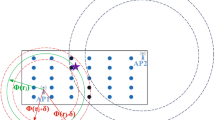Abstract
Location awareness is critical for supporting location-based access control (LBAC). The challenge is how to determine locations accurately and efficiently in indoor environments. Existing solutions based on WLAN signal strength either cannot provide high accuracy, or are too complicated to accommodate to different indoor environments. In this paper, we propose a statistical indoor localization method for supporting location-based access control. First, in an offline training phase, we fit a locally weighted regression and smoothing scatterplots (LOESS) model on the signal strength received at different training locations, and build a radio map that contains the distribution of signal strength. Then, in an online estimation phase, we determine the locations of unknown points using maximum likelihood estimation (MLE) based on the measured signal strength and the stored distribution. In addition, we provide a 95% confidence interval to our estimation using a Bootstrapping module. Compared with other approaches, our method is simpler, more systematic and more accurate. Experimental results show that the estimation error of our method is less than 2m. Hence, it can better support LBAC applications than others.












Similar content being viewed by others
References
Ardagna C, Cremonini M, Damiani E, Vimercati S, Samarati P (2006) Supporting location based access control policies. In: Proc. 2006 ACM symposium on information, computer and communications security (ASIACCS), pp 212–222
Bahl P, Padmanabhan V (2000) RADAR: an in-building RF-based user location and tracking system. In: Proc. IEEE INFOCOM, pp 75–784
Cleveland W (1979) Robust locally weighted regression and smoothing scatterplots. J Am Stat Assoc 74(368):829–836, December
Cleveland W, Devlin S (1988) Locally weighted regression: an approach to regression analysis by local fitting. J Am Stat Assoc 83(403):596–610, September
Covington M, Long W, Srinivasan S, Dey A, Ahamad M, Abowd G (2001) Securing context-aware applications using environment roles. In: Proc. 6th ACM symposium on access control models and technologies (SACMAT), pp 10–20
Denning D, MacDoran P (1996) Location-based authentication: grounding cyberspace for better security. In: Denning D, Denning P (eds.) Internet besieged: countering cyberspace scofflaws, pp 167–174. ACM/Addison-Wesley, New York
Fisher R (1992) On the mathematical foundations of theoretical statistics. Philos Trans R Soc Lond Ser A 222:309–368
Fisher R (1992) The goodness of fit of regression formulae, and the distribution of regression coefficients. J R Stat Soc 85(4):597–612, June
Fisher R (1997) On an absolute criterion for fitting frequency curves. Stat Sci 12(1):39–41
Harter A, Hopper A, Steggles P, Ward A, Webster P (1999) The anatomy of a context-aware application. In: Proc. ACM MobiCom, pp 59–68, August
Hall P (1992) The bootstrap and edgeworth expansion. Springer, New York
Hurvich C, Simonoff J, Tsai C (1998) Smoothing parameter selection in nonparametric regression using an improved akaike information criterion. J R Stat Soc Ser B 60(2):271–293
Lim H, Kung L, Hou J, Luo H (2006) Zero-configuration, robust indoor localization: theory and experimentation. In: IEEE INFOCOM, Barcelona, 23–29 April 2006
NetStumbler (2007) NetStumbler homepage. http://www.netstumbler.com. Accessed 24 June 2008
Niculescu D, Nath B (2004) VOR base stations for indoor 802.11 positioning. In: Proc. ACM MobiCom, pp 58–69, September
NIST (2006) LOESS (aka LOWESS). NIST/SEMATECH e-handbook of statistical methods. http://www.itl.nist.gov/div898/handbook/pmd/section1/pmd144.htm. Accessed 25 September 2008
Youssef M, Youssef A, Rieger C, Shankar U, Agrawala A (2006) PinPoint: an asynchronous time-based location determination system. In: Proc. ACM MobiSys, pp 165–176, June
Priyantha N, Chakraborty A, Balakrishnan H (2000) The cricket location-support system. In: Proc. ACM MobiCom, pp 32–43, August
The R Project for Statistical Computing (2008) The R Project for Statistical Computing. http://www.r-project.org/. Accessed 30 July 2008
Want R, Hopper A, Falcão V, Gibbons J (1992) The active badge location system. ACM Trans Inf Sys (TOIS) 10(1):91–102, January
Youssef M, Agrawala A (2005) The Horus WLAN location determination system. In: Proc. ACM MobiSys, pp 205–218, June
Author information
Authors and Affiliations
Corresponding author
Additional information
This work was partially supported by US National Science Foundation (NSF) under grants CNS-0644238 and CNS-0626822. A preliminary version of the paper has appeared in QShine 2008.
Rights and permissions
About this article
Cite this article
Gao, C., Yu, Z., Wei, Y. et al. A Statistical Indoor Localization Method for Supporting Location-based Access Control. Mobile Netw Appl 14, 253–263 (2009). https://doi.org/10.1007/s11036-008-0143-4
Published:
Issue Date:
DOI: https://doi.org/10.1007/s11036-008-0143-4




